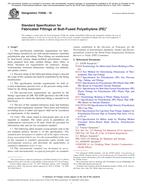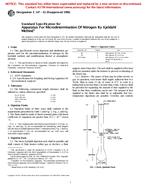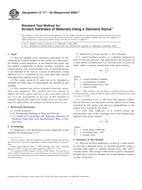1.1 These test methods cover the determination of the Rockwell hardness and the Rockwell superficial hardness of metallic materials, including test methods for the verification of machines for Rockwell hardness testing (Part B) and the calibration of standardized hardness test blocks (Part C).
1.2 Values stated in inch-pound units are to be regarded as the standard. SI units are provided for information only.
This standard does not purport to address all of the safety concerns, if any, associated with its use. It is the responsibility of the user of this standard to establish appropriate safety and health practices and determine the applicability of regulatory limitations prior to use.
Note 2
The National Institute of Standards and Technology (NIST) maintains the national Rockwell hardness standards for the United States. In June 1998, NIST released new Rockwell C scale (HRC) test blocks as Standard Reference Materials (SRMs). The blocks were calibrated using NIST’s primary reference standardizing machine. The major benefit of the NIST standards is that their HRC levels are in line with the other industrialized countries around the world. The NIST HRC levels establish the hardness of materials slightly harder than the historical standards used in the United States for the past 75 years. The revision of E 18 requires that all performance verifications of Rockwell hardness indenters and hardness machines must be made using test blocks calibrated traceable to the Rockwell standards maintained by NIST. This can be accomplished through the use of commercial test blocks calibrated traceable to the NIST standards or by directly using the NIST SRMs. This requirement will apply only to the Rockwell scale(s) for which NIST supplies primary reference test blocks
Note 3
Previous editions of this standard have stated that the steel ball was the standard type of Rockwell indenter ball. Starting with this edition, the tungsten carbide ball is considered the standard type of Rockwell indenter ball. The use of tungsten carbide balls will provide an improvement to the Rockwell hardness test because of the tendency of steel balls to flatten with use, which results in an erroneously elevated hardness value. The user is cautioned that Rockwell hardness tests comparing the use of steel and tungsten carbide balls have been shown to give different results. For example, depending on the material tested and its hardness level, Rockwell B scale tests using a tungsten carbide ball indenter have given results up to one Rockwell point lower than when a steel ball indenter is used.
Product Details
- Published:
- 04/01/2005
- Number of Pages:
- 22
- File Size:
- 1 file , 290 KB


